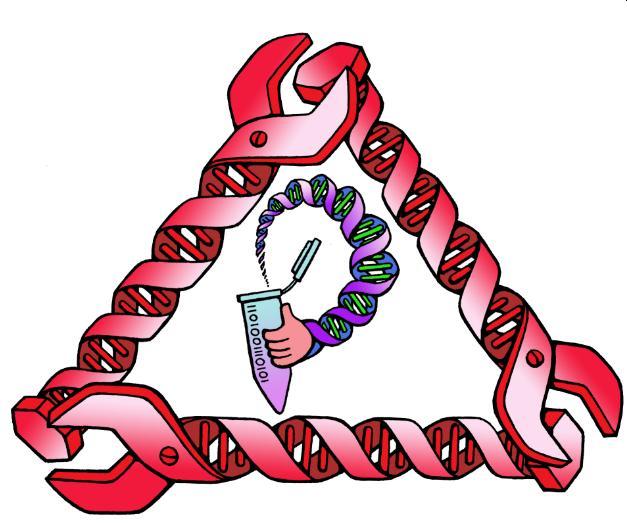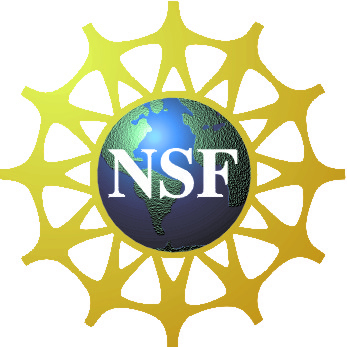17th International Conference on
DNA Computing and Molecular Programming
California Institute of Technology
Beckman Institute
Pasadena, California, USA
September 19 - 23, 2011
There will be three 90 minute lecture-style tutorials on Sept. 19:
- David Doty: Theory of Algorithmic Self-Assembly with DNA Tiles
Abstract: Self-assembly is the process by which simple components automatically assemble themselves into larger structures, such as self-assembly of individual DNA strands into large, complex polymer structures. Algorithmic self-assembly is distinguished by having much fewer types of components in the final structure than total components, so that components must compute where to attach using only local information. This is in analogy to a Turing machine using only its current state and local memory to decide the next move. One particular model of DNA self-assembly, the Tile Assembly Model introduced by Winfree in 1998, has received extensive theoretical study, largely by computer scientists studying the unique computational aspects of self-assembly. In this tutorial, we review this theory, focusing on the following themes:
- Motivation and definition of the model
- Fundamental theoretical results
- Connections to other areas of mathematics and computer science
- Brief introduction to the papers and posters in DNA 17 on theoretical tile assembly
There will also be some discussion of experimental implementations of the Tile Assembly Model, although this is not the central focus of the tutorial. talk (OpenOffice)
talk (PowerPoint)
- David Soloveichik: The Programming Language of Chemical Kinetics, and How To Discipline Your DNA Molecules using Strand Displacement Cascades
Abstract: An abstract chemical reaction network (CRN) is simply a set of formal coupled chemical reactions between certain chemical species A, B, C... Traditionally, CRNs have been used only as a descriptive language in order to model and analyze existing chemical systems. However, I will argue that CRNs constitute a natural choice for a prescriptive "programming language" to specify the desired behavior of engineered chemical system. I will show a few examples of basic algorithms written with CRNs, and discuss some theoretical open questions.
Switching gears, in the second part of the talk I will give a tutorial on strand displacement cascades. While CRNs are abstract specifications of behavior, nucleic acid strand displacement cascades allow making such specification a physical reality. My tutorial will be general, aimed at introducing you to this powerful programmable reaction primitive, which appears in a number of works at this conference.
talk (PDF)
- Eric Klavins: Specification and Control of Stochastic Biochemical Systems
Abstract: Chemical reactions that occur inside cells are quite noisy, primarily due to the small numbers of molecules involved. Nevertheless, cells are capable of tight control of chemical reactions using feedback and other mechanism. Synthetic biologists are beginning to understand, mimic, and redeploy these mechanisms, building on a growing understanding of how randomness in cells works. In this tutorial, we will describe in detail the stochastic model of chemical reaction networks, including: the derivation of the master equation, moment dynamics, finite state projection, mixed low-copy number (discrete) and concentration based (continuous) systems. In addition, we will describe several problems in designing and controlling biochemical systems so that means, variances, and covariances match performance specifications. Finally, we will discuss various distributed algorithms, such as consensus and leader election, that require random number generators to function. We will describe how such algorithms can be implemented by stochastic chemical reactions and how to simulate their behavior in spatial models of cell-growth.
talk (PDF)
- Elisa Franco, Jongmin Kim, and Josh Bishop: Genelets: synthetic in vitro transcriptional circuits
This tutorial will introduce the in vitro transcriptional circuits toolkit. The tutorial will focus on the design, synthesis and experimental testing of a synthetic oscillator built using components from this toolkit. First, we will provide a brief theoretical introduction to transcriptional circuits, with overviews of
- The main features transcriptional circuits, including achievable dynamic behaviors
- The general design process for genelet circuits, with focus on two and three node oscillators
- The protocols and experimental techniques needed to implement genelet circuits in the lab.
A laboratory session will follow, where the participants will individually run the protocols provided and collect oscillatory trajectories data for a two-node oscillator. Finally, we will describe some of the software tools that can be used to design and simulate transcriptional circuits. Participants will be encouraged to pursue a design project of their choice using the software (options/project outlines will be provided). Genelet Animations (PowerPoint)
Instructions (PDF)
Synthetic in vitro transcriptional oscillators (PDF)


